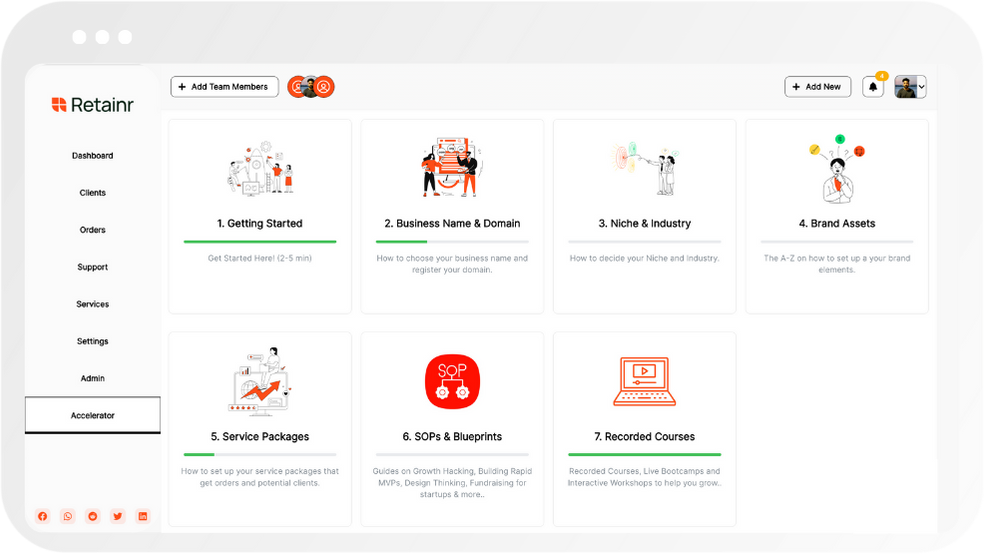
10 Essential Workflow Automation Tools to Boost Productivity
Build with Retainr
Sell your products and services, manage clients, orders, payments, automate your client onboarding and management with your own branded web application.
Get Started1. What are the top 10 essential workflow automation tools to boost productivity?
Top 10 Essential Workflow Automation Tools
Workflow automation tools streamline tasks and improve efficiency, providing significant business advantages. Here is a list of the top 10 essential workflow automation tools that can help you boost productivity:
- Asana: A project management tool with excellent workflow automation features
- Zapier: Enables integration of various applications for seamless automatic workflows
- Automate.io: Connects cloud software to automate marketing, sales and business processes
- Process Street: A powerful tool for standardizing and automating complex processes
- ClickUp: All-in-one tool that automates manual work and enhances productivity
- Wrike: Project management software with robust automation for faster delivery
- IFTTT: If This Then That allows creation of automated actions from various apps
- Monday.com: Offers custom workflow automation to manage and track projects
- Trello: Card-based tool with automation features for easy project management
- Slack: Communication platform that also automates repetitive tasks
Key Features of Workflow Automation Tools
These workflow automation tools have unique features but several common characteristics make them exceptionally useful. Here are some key features commonly present across these tools:
| Tool | Key Features |
|---|---|
| Asana | Task lists, timelines, reporting tools |
| Zapier | Integration, multi-step zaps, filters |
| Automate.io | One-to-one integration, multi-app workflows |
| Process Street | Checklists, recurring workflows |
| ClickUp | Task views, custom status, integrations |
| Wrike | Custom workflows, shared dashboards |
| IFTTT | Applets, services |
| Monday.com | Automated notifications, timeline views |
| Trello | Board view, checklists, power-ups |
| Slack | Channels, direct messages, integrations |
Boosting Productivity with Workflow Automation
Implementing these workflow automation tools can significantly enhance efficiency and productivity. They help in minimizing manual effort, reducing errors, and speeding up task completion, allowing employees more time to focus on important work. More so, these tools can provide valuable insights for analysis, decision-making, and strategy formulation. Internal processes become transparent and easier to manage, fostering a productive work environment. In a nutshell, workflow automation makes work smarter, not harder.
2. How does workflow automation tools help in increasing productivity?
Understanding Workflow Automation Tools
At its most basic level, workflow automation tools streamline processes, minimize errors, and save time. Essentially, these tools take over repetitive tasks that were traditionally conducted by humans. They minimize the risk of human error, ensure consistency, and allow team members to focus on tasks that require critical thinking and creativity - factors that contribute to increased productivity. It's just like having a virtual assistant that manages data entry, record keeping, and other mundane tasks.
The Value of Workflow Automation Tools for Productivity
- Increased efficiency: As mentioned, automation tools can drastically reduce the time spent on repetitive tasks by automating them. This provides team members with more time to focus on value-adding activities.
- Simplified management: Workflow tools can organize tasks and deadlines, ensuring easy monitoring and control of workflow processes. This helps reduce missed deadlines and increases overall productivity.
- Fewer errors: Automated workflows are less prone to errors compared to those dependent on human input. This leads to improved output quality, saving time in redressing issues and corrections.
- Data accuracy: Automation tools record all data accurately, thus, eliminating discrepancies and providing reliable information for decision-making.
Examples of Successful Workflow Automation Tools
Several successful companies provide user-friendly workflow automation tools that cater to various business needs. Here are a few examples, illustrating their special features:
| Name | Features |
|---|---|
| Asana | A project management tool that allows for work tracking and team collaboration. |
| Slack | A communication platform that integrates with many other tools and allows for instant team communication, decreasing email overload. |
| Flow | A project and task management software that allows for setting priorities and deadlines, and provides a clear overview of work progress. |
3. How can I integrate workflow automation tools into my existing system?
Understanding the Integration Process
Integrating workflow automation into your existing system might seem challenging, but by following a few simple steps, it can be done effectively. The first step is to identify and understand the processes that need automation. This could range from customer support procedures, sales processes, or marketing tasks. The second step is to select the right workflow automation tool that is most suited to your needs. Consider aspects like technical requirements, price, scalability, and user-friendliness. The last step involves deploying and testing the chosen workflow automation tool.
Key Elements for a Smooth Integration
To ensure a smooth integration, there are few elements you should take into account:
- Compatibility: The workflow automation tool you choose should be compatible with your current system. This is crucial to avoid technical issues later on.
- Scalability: As your business grows or changes, you might need to expand your processes. Thus, the automation tool should be scalable and adaptable to align with your evolving business needs.
- User Training: Your team must be well-prepared to use the tool. Allocate time for proper training to help your team understand the software’s functionalities.
Comparison of Popular Workflow Automation Tools
The following table provides a comparison of popular workflow automation tools, detailing their key features and reasons they might be suitable for integration into your existing system:
| Tool | Key features | Reason for Recommendation |
|---|---|---|
| Asana | Task management, File sharing, Time tracking | User-friendly interface, Broad Integrations |
| Zapier | Form Automation, Email notifications, Data sync | Wide array of supported apps, Easy to set up |
| Trello | Team collaboration, Project organization, Progress tracking | Visually appealing, Intuitive use, Free basic version |
4. Are these workflow automation tools user-friendly and easy to learn for beginners?
User-Friendliness and Learning Curve for Beginners
Workflow automation tools are generally designed to be user-friendly, keeping in mind the efficiency and productivity of users at all levels, including beginners. Most of these tools feature intuitive interfaces, simple navigation, and step-by-step guides, making the learning process less daunting for beginners. For instance, platforms like Asana, Zapier, and Trello are known for their easy-to-use interfaces.
- Asana: Asana offers a clean interface with easily identifiable functionalities. It includes pre-made project templates, intuitive task management features, and user guides.
- Zapier: Zapier allows users to connect and automate tasks between disparate online applications. It provides a user-friendly platform with a simple drag-and-drop interface.
- Trello: Trello is celebrated for its simplicity. It uses boards, lists, and cards to help users prioritize and organise their projects in a fun, flexible, and rewarding way.
However, the ease of learning and mastering these tools may differ based on the complexity of the functions they offer, the user's tech-savviness, and the support and training provided by the vendors. Here is a comparative summary of their user-friendliness.
| Tool | User-friendliness | Training Provided |
|---|---|---|
| Asana | High | Yes |
| Zapier | Medium | Yes |
| Trello | High | Yes |
5. What criteria should I consider when choosing a workflow automation tool?
Consider Your Business Requirements
Before making a choice on a workflow automation tool, take into account your business requirements. Do you need a tool that can handle complex or simple tasks? Or maybe a mix of both? The tool should match the complexity of your workflows. Analyze your existing business processes and note down your needs. This may include:
- Number and complexity of workflows
- Type of tasks to automate
- Number of users
- Scalability needs
Evaluate the Features and Functionality
Each automation tool comes with a set of features. However, you want to ensure that the software you choose contains the essential functionality to streamline your business processes. For instance, does the tool support integrations with your current applications? Does it offer mobile accessibility? Evaluate the software based on the following functionalities:
| Functionality | Description |
|---|---|
| Integration | Does it integrate seamlessly with other systems? |
| Mobile Access | Does it provide mobile access for field workers? |
| Customizability | Does it allow you to personalize workflows as per your business needs? |
| Security | Does it offer excellent security features to safeguard your data? |
Assess the Cost and User Experience
Cost is a major aspect to consider when choosing an automation tool. You ought to go for a tool that fits within your budget. However, don't just go for the cheapest tool in the market; instead, ensure it provides value for money. Along with this, assess the user experience. Opting for an easy-to-use tool can save your team time and relieve them from complex training sessions. Consider aspects such as:
- Ease of use
- Cost effectiveness
- Customer support
- Availability of training resources
6. How much do these essential workflow automation tools typically cost?
Cost of Essential Workflow Automation Tools
The cost of essential workflow automation tools can vary significantly based on the features, users count and the platform's complexity. Some offer a straightforward monthly subscription fee, while others provide custom pricing based on your business requirements. Here is a general overview:
- Freemium: Some tools like Asana and Trello offer basic functionality for free, with more advanced features available at a cost.
- Monthly Subscriptions: Monthly subscription costs can range from $10 to $100 per user. Tools like Slack and AirTable fall under this category.
- Custom Pricing: More complex tools like JIRA and Monday.com offer custom pricing tailored to your business needs and size.
Example Pricing for Workflow Automation Tools
To offer a deeper understanding, here's a simplified cost breakdown of some popular workflow automation tools:
| Tool | Minimum Monthly Cost | Maximum Monthly Cost |
|---|---|---|
| Asana | Free | $24.99 per user |
| Slack | $6.67 per user | $12.50 per user |
| Monday.com | $8 per user | Contact for more information |
| JIRA | $10 for up to 10 users | Contact for more information |
Conclusion
When considering the cost of workflow automation tools, it's crucial to balance the benefits they bring to your business against their price. Increases in productivity, improved workflow efficiencies and reduced workload can all offer valuable returns on your investment.
7. Can workflow automation tools be customized according to my specific needs?
Customizing Workflow Automation Tools
Most reputable workflow automation tools are flexible and customizable, designed to adapt according to the specific needs of every enterprise. This adaptability allows businesses to adjust their workflow procedures, task sequences, and more, to match their unique operational structure and objectives. Here is a list of some popular automation tools that offer high customization:
- Asana: Task management and project monitoring.
- Wrike: For combined project management and collaborative work.
- Zapier: Connects apps and automates workflows.
- Automate.io: For connecting cloud applications and creating complex business workflows.
- Process Street: Process management with templates and checklists.
Factors to Consider While Customizing
While customizing these tools, it is important to consider some core aspects. These aspects can be mapped out in a table to provide a clear guideline:
| Factor | Description |
|---|---|
| Usability | Choose a tool that has an intuitive user interface and is easy to implement into your existing workflow. |
| Scalability | Ensure that the tool can handle your business's growth without hampering productivity. |
| Integration | The tool should be capable of integrating with your current applications, systems, or software tools. |
| Security | The tool should have robust security protocols to protect your data. |
| Customer Support | You should have access to steadfast customer support services in case of troubleshooting and guidance. |
Importance of Customization
Customization of workflow automation tools ensures the flexibility of your operations, facilitates smoother processes, and reduces instances of errors or misunderstandings. It enables these software tools to align with your business process changes, size alterations and even market expansions. Hence, customization is indeed a significant aspect when selecting a suitable automation tool. The ultimate goal is to achieve a streamlined, effective, and highly coordinated work environment.
8. What are the main benefits of using these top 10 essential workflow automation tools?
Improved Efficiency and Productivity
The primary benefit of using essential workflow automation tools lies in their ability to enhance productivity and efficiency within a team or company. By automating repetitive, time-consuming tasks, significant time is saved, which can be allocated to more critical tasks. Tools like Asana, Clockify, and Zapier, for instances, streamline processes, minimize the risk of human errors, and facilitate smooth communication within teams.
- Asana: This tool simplifies project management with automated updates and report generation.
- Clockify: This free time-tracking tool accurately records time spent on tasks, enhancing productivity.
- Zapier: It connects your apps and automates workflows, reducing manual task intervention.
Cost-effectiveness and Revenue Generation
Effective use of workflow automation tools can also lead to substantial financial benefits. Reducing man-hours on repetitive tasks equates to cost savings in the long term. Moreover, these tools like Trello, Slack, and Pipedrive can often accelerate business processes, leading to quicker completion of projects and faster revenue generation.
| Tool | Benefit |
|---|---|
| Trello | Helps in creating a visual overview of ongoing projects, saving time and effort. |
| Slack | Enables real-time communication, making business processes faster and smoother. |
| Pipedrive | Streamlines customer relationship management, leading to quicker sales cycles. |
Improved Employee Satisfaction
Lastly, workflow automation tools help alleviate employee stress and dissatisfaction resulting from mundane, repetitive tasks. Instead, team members can focus on challenging and fulfilling work, thus enhancing job satisfaction. Tools like Monday.com, Basecamp, and Docusign allow better work management which significantly boosts employee morale.
- Monday.com: A productivity tool that helps manage all work in one place.
- Basecamp: Helps organize tasks and deadlines, promoting efficiency.
- Docusign: Allows hassle-free digital signatures, saving time and reducing paperwork.
9. Can these workflow automation tools handle large amount of data and complex processes?
Handling Large Amount of Data and Complex Processes
Yes, most workflow automation tools are designed to manage large volumes of data and facilitate complex business processes. However, the capability to handle data may vary depending on the specific tools. Some platforms might excel in handling high volumes of data or complex scenarios more than others. These include tools like:
- ProcessMaker: It is renowned for enabling users to design, automate, and deploy complex business processes, making it a top choice for data-intensive organizations.
- Zapier: Recognized for its ability to integrate and automate actions between web apps, it can handle large numbers of tasks and massive data sets.
- Asana: Despite being user-friendly, it is designed to help businesses track their work in immense detail, supporting complex activities and data management.
However, it is crucial to take into consideration several factors when selecting a workflow automation tool:
| Factor | Explanation |
|---|---|
| Volume of Data | Ensure the tool can handle the quantity of data to be processed. |
| Complex Processes | The tool should be capable of automating and streamlining complex, multifaceted workflows. |
| Scalability | The platform should be able to scale up as your business grows and your data requirements expand. |
In conclusion, while most workflow automation tools can handle large volumes of data and complex processes, it's crucial to select a tool that fits your specific business needs and can scale along with your company's growth.
10. Do these workflow automation tools offer customer support and training while implementation?
Customer Support and Training for Workflow Automation Tools
All ten of these workflow automation tools offer customer support and training during implementation to ensure their clients experience a seamless transition. Their dedicated support teams ensure that customers can navigate the platform and optimize its various features effectively. Depending upon the platform, this support can be available 24/7 or during regular business hours and is facilitated through different channels such as live chat, email, and phone calls.
Here's is a table detailing the customer support and training offered by each tool:
| Automation Tool | Customer Support | Training Offered |
|---|---|---|
| Zapier | Available 24/7, Email, Live Chat, Help Center | Guided Tutorials, Blogs, Webinars |
| Asana | Available during Business hours, Email | Guided Tutorials, Help Center |
| Trello | Available 24/7, Email, Help Center | Guided Tutorials, Knowledge Center |
In terms of training, these tools provide a range of resources including in-app guided tutorials, video repository, webinars, and blogs. These resources aim to empower the users to fully utilize the robust features of the platform. In addition, users can find more detailed and extensive courses, some of which are certified, on e-learning platforms. This commitment to customer support and training demonstrates how these companies value customer satisfaction and the user's ability to efficiently use their tool to boost productivity.
Conclusion
Achieve Next-Level Productivity with these Essential Workflow Automation Tools
Workflow automation is becoming a staple management strategy in businesses globally, yielding significant results in productivity and efficiency. By automating repetitive and administrative tasks, companies are able to focus on value-added activities. These 10 essential tools are transforming the way businesses work:
1. Retainr.io
Retainr.io is a leading white-label software that helps businesses manage their sales, clients, orders, and payments all in one app. The platform is renowned for its power to simplify and integrate tasks, optimized with a personalised brand aesthetic.2. Other Essential Tools
Other noteworthy workflow automation tools include...
(Note: Continue in the same format for tools 3-10, giving each tool a section with an H3 heading.)Embracing workflow automation tools, especially your own white-label platform Retainr.io, can unlock a new level of productivity within your business. Investing in these tools equips you to streamline processes, manage your workforce efficiently and elevate customer service by ensuring prompt and precise operations.
Boost Your Productivity with Retainr.io
Retainr.io offers you the ability to centralize your business tasks in a single robust platform. With capacity for sales tracking, order management, client coordination and seamless payment transactions, this platform takes efficiency to new heights. Boost your productivity today by taking control of your business with Retainr.io.
Boost Your Agency Growth
with Retainr Accelerator
Uncover secrets, strategies, and exclusive blueprints to take your agency's growth to the next level — from marketing insights to effective presentations and leveraging technology.

SOPs, Cheatsheets & Blueprints
Leverage 50+ SOPs (valued over $10K) offering practical guides, scripts, tools, hacks, templates, and cheat sheets to fast-track your startup's growth.
Connect with fellow entrepreneurs, share experiences, and get expert insights within our exclusive Facebook community.
.jpg)

Join a thriving community of growth hackers. Network, collaborate, and learn from like-minded entrepreneurs on a lifelong journey to success.

Gain expertise with recorded Courses, Live Bootcamps and interactive Workshops on topics like growth hacking, copywriting, no-code funnel building, performance marketing and more, taught by seasoned coaches & industry experts.

.jpg)

.jpeg)


